Neel Megh Shyama – Krishna Is Shyama Because His Name Itself Reflects the Color of the Universe
Ankit Gupta | May 01, 2025, 13:38 IST
"Neel Megh Shyama" literally means "dark as the blue-black raincloud"—a description often used for Krishna in scriptures like the Bhagavata Purana. But as you rightly said, Krishna is not blue in the literal sense. The name Krishna (कृष्ण) itself means "dark," "black," or "the all-attractive"—and this darkness is symbolic, not superficial
"Shyam rang rangya re, mero pritam pyara..."
Drenched in the hue of Shyama, I dissolve.
When we utter the name Krishna, we summon a force, a presence, a vibration that is beyond the veil of duality. The name itself is a contradiction: Krishna—the dark one, yet the most radiant. The all-attractive, yet beyond form. The blue god who is not blue, but black like the universe itself.
Let us enter the mystic womb of this contradiction.
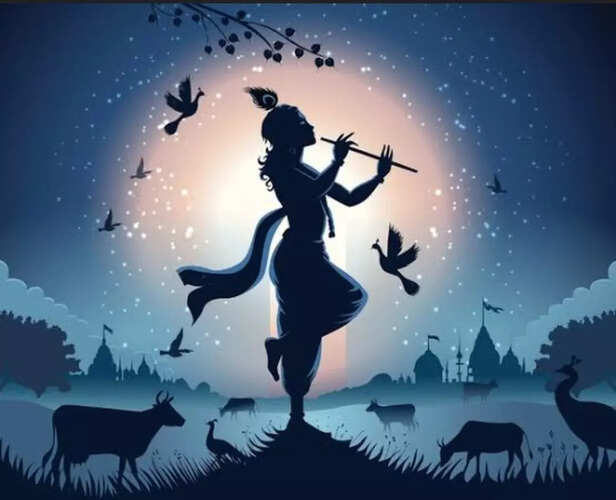
When the first astronomers peered into the telescope, beyond the glittering stars, they saw darkness. And when the sages peered inward, past the mind, past the senses, they too found darkness. Not the darkness of fear—but the darkness of source. Of infinity. Of that which cannot be divided.
The color of the universe is not white or light. It is black. That is not absence. It is potential. In the womb of blackness, all things are born. This is the mystery of Krishna—the one whose very name means "dark," yet who reveals the most dazzling truths.
"Neel Megh Shyama"—dark as a rain-laden cloud. Not the pale blue of calm seas, but the thunder-womb that carries lightning.
In this metaphor, Krishna is the cosmic storm.
He is not fair. He is not golden. He is not shining. He is absorbing. Absorbing everything into himself, like black holes. Like Truth.
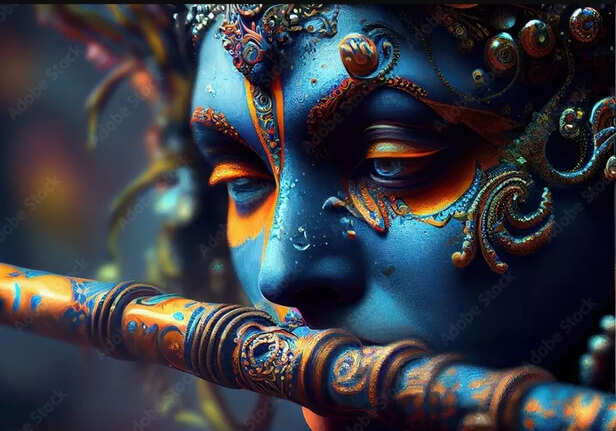
Why do artists paint him blue? Because our minds are not yet ready to accept darkness as divine. Because we have been taught that light is good and dark is evil. Because we fear the night, forgetting that night is when we dream. Night is when the seed cracks.
Blue is a compromise. Blue is the visible spectrum's attempt to touch the invisible. Just as Krishna is form touching the formless.
But Krishna is not blue. He is Shyama. He is dark. He is the infinite space between stars, the sound between words, the rest between musical notes. He is the ink of the Upanishads, the silence of meditation, the black soil that births the golden harvest.
He is not "colored"; he colors all.
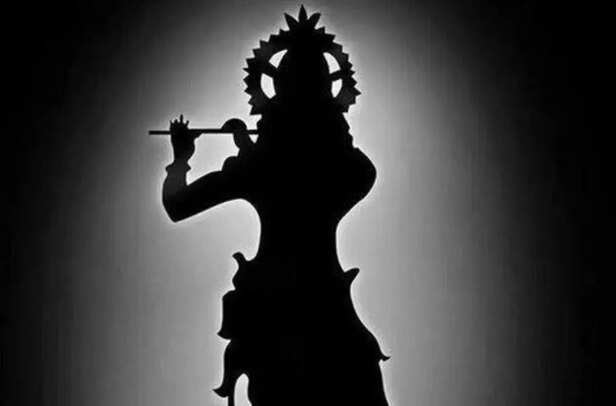
Just as black absorbs all colors, Krishna absorbs all beings. He does not judge the color you wear—he devours it. Thief of hearts, he steals everything until you are empty, then fills you with himself.
Radha did not love a charming boy. She loved the abyss of love itself. She did not choose light—she merged into the black flame. And in that, she became more than herself. She became the devotee, the archetype, the river that dissolves into the sea of Krishna.
This is the secret. We fall in love with Krishna not because he is understandable, but because he is the ungraspable.
He is the black mirror. The more you look, the more you disappear.
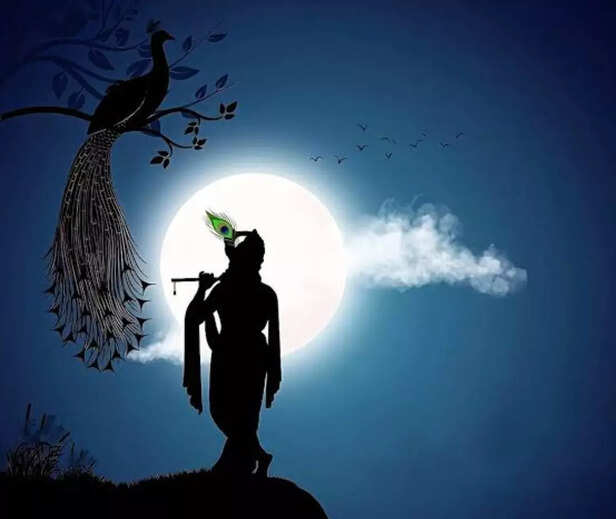
We live in a world that glorifies the visible, the loud, the illuminated. But the sages knew: True power is hidden. True love is silent. True beauty lies in the unseen.
This is why Krishna is dark. So you cannot see him—you must feel him. He walks not under a spotlight, but in the moonshadow. He is the dancer whose anklets are silent.
He teaches by disappearing. He wins wars by not fighting. He sings, and you forget the path, and find yourself at the destination.
This is not a god who shines. This is a god who envelops.
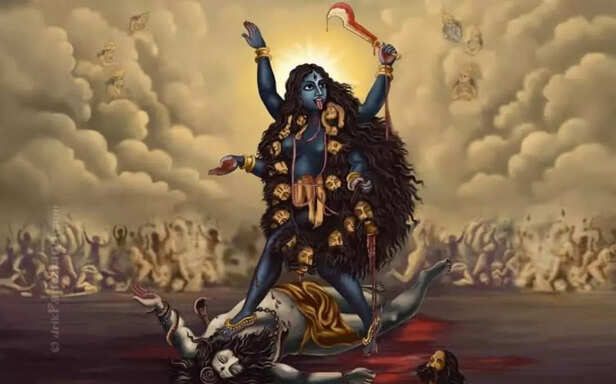
The feminine of Shyama is Shyama Herself—Kali. She too is dark. She too is misunderstood. She too is painted in blue sometimes to soothe our conditioned eyes. But she is the same truth as Krishna: The one who dances in the cremation ground. The one who wears time around her neck.
Krishna and Kali are not opposites. They are the same cosmic night. He is the flute; she is the drum. He is the lover; she is the liberator.
Both tell us the same thing: Come into the dark. Leave behind the known. Become.
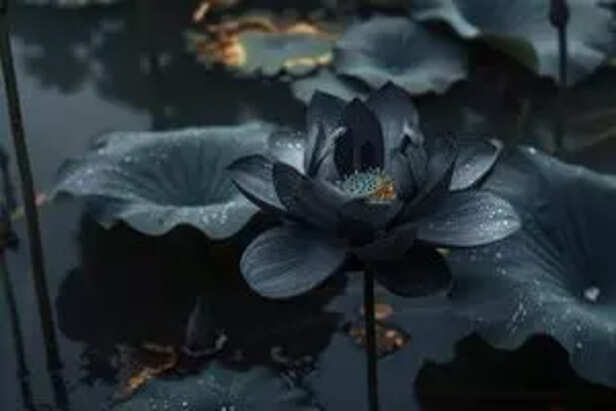
In Tantric symbology, the thousand-petaled lotus—the crown of consciousness—is not white. It is black. It is called Neel Padma.
From that lotus blooms Krishna. From that lotus descends all avatars.
This is why yogis close their eyes—to see that color. To see Him.
In the dark cave of the heart, Krishna plays his flute. In the silence of surrender, he begins to speak. In the death of ego, he is born.
This is not metaphor. This is the way.
When Arjuna saw the Vishwaroopa, he saw fire, light, terror, and majesty. But when he remembered Krishna the friend—the charioteer, the cowherd—it was not light he remembered. It was comfort. It was depth. It was the infinite dark eyes that saw all and forgave all.
That is the gift of Krishna. To be known not through logic, but through longing. To be felt, not seen.
Because you cannot worship the universe by measuring it. You must close your eyes. You must bow into the dark. And find there the supreme light.
In the end, all things will return to the source. The stars will die. The galaxies will collapse. The light will fade.
What remains? The black. The Krishna. The truth.
He is not one among gods. He is the canvas on which the gods are painted. He is not the flute-player in Vrindavan alone. He is the unstruck sound, the anahata—heard only in the heart.
He is Neel Megh Shyama. The cosmic black. The eternal. The All.
So next time you close your eyes in prayer— Do not fear the dark. It is not absence. It is Him.
"Krishna is not blue. He is the color before color. He is the moment before creation. He is the lover who devours all form, all name, and leaves you as lightless light."
Bow not to the image. Bow to the silence behind it. Bow to the Shyama who is always watching.
Jai Shyama. Jai Krishna.
Drenched in the hue of Shyama, I dissolve.
When we utter the name Krishna, we summon a force, a presence, a vibration that is beyond the veil of duality. The name itself is a contradiction: Krishna—the dark one, yet the most radiant. The all-attractive, yet beyond form. The blue god who is not blue, but black like the universe itself.
Let us enter the mystic womb of this contradiction.
The Color of the Cosmos

Cosmos Within Frame (Image Credit: Pixel)
When the first astronomers peered into the telescope, beyond the glittering stars, they saw darkness. And when the sages peered inward, past the mind, past the senses, they too found darkness. Not the darkness of fear—but the darkness of source. Of infinity. Of that which cannot be divided.
The color of the universe is not white or light. It is black. That is not absence. It is potential. In the womb of blackness, all things are born. This is the mystery of Krishna—the one whose very name means "dark," yet who reveals the most dazzling truths.
"Neel Megh Shyama"—dark as a rain-laden cloud. Not the pale blue of calm seas, but the thunder-womb that carries lightning.
In this metaphor, Krishna is the cosmic storm.
He is not fair. He is not golden. He is not shining. He is absorbing. Absorbing everything into himself, like black holes. Like Truth.
The Blue Illusion

Image Credit: Pixabay
Why do artists paint him blue? Because our minds are not yet ready to accept darkness as divine. Because we have been taught that light is good and dark is evil. Because we fear the night, forgetting that night is when we dream. Night is when the seed cracks.
Blue is a compromise. Blue is the visible spectrum's attempt to touch the invisible. Just as Krishna is form touching the formless.
But Krishna is not blue. He is Shyama. He is dark. He is the infinite space between stars, the sound between words, the rest between musical notes. He is the ink of the Upanishads, the silence of meditation, the black soil that births the golden harvest.
He is not "colored"; he colors all.
The Black Attraction

Image Credit: Freepik
Just as black absorbs all colors, Krishna absorbs all beings. He does not judge the color you wear—he devours it. Thief of hearts, he steals everything until you are empty, then fills you with himself.
Radha did not love a charming boy. She loved the abyss of love itself. She did not choose light—she merged into the black flame. And in that, she became more than herself. She became the devotee, the archetype, the river that dissolves into the sea of Krishna.
This is the secret. We fall in love with Krishna not because he is understandable, but because he is the ungraspable.
He is the black mirror. The more you look, the more you disappear.
Darkness is Divine

Colour Blinds (Image Credit: Pixel)
We live in a world that glorifies the visible, the loud, the illuminated. But the sages knew: True power is hidden. True love is silent. True beauty lies in the unseen.
This is why Krishna is dark. So you cannot see him—you must feel him. He walks not under a spotlight, but in the moonshadow. He is the dancer whose anklets are silent.
He teaches by disappearing. He wins wars by not fighting. He sings, and you forget the path, and find yourself at the destination.
This is not a god who shines. This is a god who envelops.
From Shyama to Kali

Image Credit: Pixel
The feminine of Shyama is Shyama Herself—Kali. She too is dark. She too is misunderstood. She too is painted in blue sometimes to soothe our conditioned eyes. But she is the same truth as Krishna: The one who dances in the cremation ground. The one who wears time around her neck.
Krishna and Kali are not opposites. They are the same cosmic night. He is the flute; she is the drum. He is the lover; she is the liberator.
Both tell us the same thing: Come into the dark. Leave behind the known. Become.
The Black Lotus

Image Credit: Freepik
In Tantric symbology, the thousand-petaled lotus—the crown of consciousness—is not white. It is black. It is called Neel Padma.
From that lotus blooms Krishna. From that lotus descends all avatars.
This is why yogis close their eyes—to see that color. To see Him.
In the dark cave of the heart, Krishna plays his flute. In the silence of surrender, he begins to speak. In the death of ego, he is born.
This is not metaphor. This is the way.
The Supreme Truth Hidden in Shadow
That is the gift of Krishna. To be known not through logic, but through longing. To be felt, not seen.
Because you cannot worship the universe by measuring it. You must close your eyes. You must bow into the dark. And find there the supreme light.
The Final Absorption
What remains? The black. The Krishna. The truth.
He is not one among gods. He is the canvas on which the gods are painted. He is not the flute-player in Vrindavan alone. He is the unstruck sound, the anahata—heard only in the heart.
He is Neel Megh Shyama. The cosmic black. The eternal. The All.
So next time you close your eyes in prayer— Do not fear the dark. It is not absence. It is Him.
"Krishna is not blue. He is the color before color. He is the moment before creation. He is the lover who devours all form, all name, and leaves you as lightless light."
Bow not to the image. Bow to the silence behind it. Bow to the Shyama who is always watching.
Jai Shyama. Jai Krishna.
